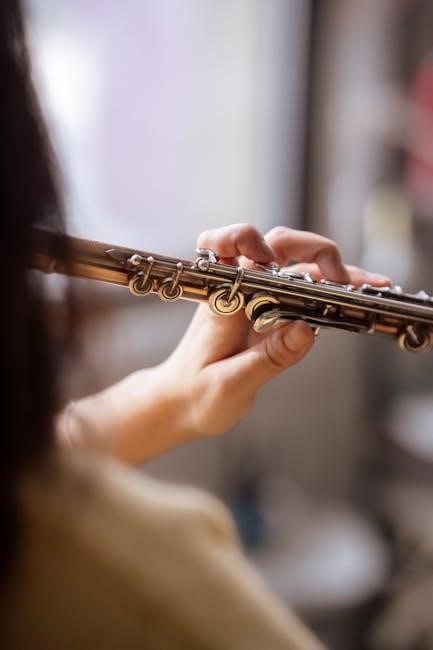poulenc flute sonata pdf
The Poulenc Flute Sonata, composed in 1957, is a three-movement work for flute and piano, showcasing Poulenc’s neoclassical style with lyrical and virtuosic elements. It is considered one of the most significant works for flute in the 20th century, blending humor, elegance, and emotional depth. The sonata is widely performed and admired for its technical challenges and expressive qualities, making it a staple in flute repertoire. It is available in PDF format for download, along with revised editions, ensuring accessibility for musicians worldwide.
1.1 Historical Background
The Poulenc Flute Sonata, composed between 1956 and 1957, is a significant work in the flute repertoire. Dedicated to the harpist Lily Laskine, it reflects Poulenc’s neoclassical style, blending lyricism and wit. The sonata was first published in 1957 and has since undergone revisions, with the flute part reviewed by Jean-Pierre Rampal, enhancing its technical accuracy. This piece marks a late-career highlight for Poulenc, showcasing his mastery of chamber music. Its historical significance lies in its innovative approach to the flute-piano duo, making it a cornerstone of 20th-century flute literature. The sonata’s enduring popularity is evident in its widespread performance and availability in PDF formats for modern musicians.
1.2 Composer’s Intent and Style

Francis Poulenc’s Flute Sonata, FP 164, exemplifies his unique blend of neoclassicism and lyricism. Composed in 1957, the work reflects Poulenc’s ability to balance humor and elegance, creating a piece that is both virtuosic and deeply expressive. The sonata’s three movements showcase Poulenc’s mastery of contrasting moods, from the lively Allegro moderato to the haunting Cantilena and the fiery Allegro con fuoco. Poulenc’s intent was to craft a work that highlighted the flute’s agility while maintaining a rich harmonic dialogue with the piano. His style, characterized by clarity and wit, ensures the sonata remains a cornerstone of 20th-century flute repertoire.
The sonata’s structure and tonal language reveal Poulenc’s late-career maturity, blending simplicity with sophistication. This duality makes the work both accessible and challenging for musicians, embodying the essence of Poulenc’s artistic vision.
Structure and Movements of the Sonata
The Poulenc Flute Sonata consists of three movements: Allegro moderato, Cantilena, and Allegro con fuoco. Each movement highlights the flute’s agility and expressive qualities, blending lyricism with virtuosity.
2.1 Allegro Moderato (First Movement)
The Allegro moderato, composed in 1956-57, is the vibrant opening movement of the Poulenc Flute Sonata. It begins with a lively, energetic theme, showcasing the flute’s agility and the piano’s rhythmic drive. The movement features a dynamic interplay between the two instruments, blending playful motifs with moments of lyrical introspection. Poulenc’s neoclassical style is evident in its structured form and harmonic clarity. The flute part demands technical precision, while the piano provides a robust harmonic foundation. This movement sets the tone for the sonata, balancing humor and elegance, and is often praised for its infectious energy and emotional depth. It remains a highlight of the work, captivating audiences with its lively charm and musical sophistication.
2.2 Cantilena (Second Movement)
The Cantilena, marked “Assez lent,” is the lyrical and expressive second movement of the Poulenc Flute Sonata. It features a hauntingly beautiful melody that showcases the flute’s ability to sing with warmth and nuance. The movement is characterized by its slow tempo and melancholic atmosphere, creating a stark contrast to the lively first movement. Poulenc’s use of harmonies and phrasing evokes a sense of introspection and emotional depth. The piano accompaniment is delicate yet supportive, allowing the flute to take center stage. This movement is often praised for its lyrical elegance and is considered one of the most memorable moments in the sonata. Its beauty and expressiveness make it a favorite among flutists and audiences alike, highlighting Poulenc’s mastery of lyrical writing for the flute.
2.3 Allegro Con Fuoco (Third Movement)
The Allegro con fuoco is a dynamic and fiery conclusion to the Poulenc Flute Sonata, showcasing both technical brilliance and rhythmic energy. Marked by its fast tempo and virtuosic demands, this movement highlights the flute’s agility and the pianist’s versatility. The music is filled with playful dialogue between the flute and piano, interspersed with moments of humor and wit. Poulenc’s neoclassical style shines through, blending intricate rhythms with a sense of lightness and charm. The movement’s climax builds to a thrilling finale, leaving a lasting impression on listeners. This finale is a testament to Poulenc’s ability to craft music that is both challenging and exhilarating, making it a standout piece in the flute repertoire. Its technical and musical demands ensure it remains a beloved yet formidable challenge for musicians.
Sheet Music and PDF Availability
The Poulenc Flute Sonata is widely available in sheet music and PDF formats from publishers like Chester Music and online platforms, ensuring easy access for musicians worldwide.
3.1 Sources for Downloading the PDF
Various online platforms offer the Poulenc Flute Sonata in PDF format, including Chester Music, JW Pepper, and Musicnotes. These platforms provide high-quality sheet music for purchase or download. Additionally, free sheet music websites like Free Sheet Music and Flute Sheet Music offer downloadable versions, though these may vary in quality. Revised editions, such as those by Jean-Pierre Rampal, are also available for a more authentic performance. Some versions are in the public domain in certain countries, making them freely accessible. Websites like Rutube and Google Drive occasionally host user-uploaded PDFs, though users should verify copyright compliance. These sources ensure musicians can easily access and perform this beloved sonata.
3.2 Revised Editions and Flute Part
The Poulenc Flute Sonata is available in revised editions, with notable updates by prominent flutists like Jean-Pierre Rampal. The flute part has been refined to reflect Poulenc’s later compositional style, offering improved balance and clarity between the flute and piano. These editions often include detailed dynamics, articulations, and phrasing, ensuring a more authentic interpretation. Publishers like Chester Music provide high-quality revised versions, incorporating Poulenc’s final adjustments. The revised editions are essential for performers seeking to capture the composer’s intent accurately. They are widely available in PDF format, making it easier for musicians to access and study the work. These updates enhance the sonata’s technical and emotional depth, making it a cornerstone of flute repertoire.

Performances and Interpretations
The Poulenc Flute Sonata has been performed by renowned flutists like Jean-Pierre Rampal and Emmanuel Pahud, showcasing its emotional depth and technical brilliance in live concerts and recordings.
4.1 Notable Recordings and Artists
The Poulenc Flute Sonata has been recorded by numerous renowned artists, with Jean-Pierre Rampal and Emmanuel Pahud delivering standout performances. Rampal’s 1967 recording with pianist Robert Veyron-Lacroix is particularly celebrated for its technical mastery and expressive nuance. Similarly, Pahud’s interpretation, known for its clarity and emotional depth, has set a high standard for modern flutists. Other notable recordings include those by James Galway, Philippe Bernold, and Sharon Bezaly, each bringing unique interpretations to the sonata. These recordings are widely available in both physical and digital formats, including PDF downloads, allowing musicians and enthusiasts to explore diverse approaches to the piece. The variety of interpretations highlights the sonata’s versatility and enduring appeal.
4.2 Live Performances and Reviews
Live performances of the Poulenc Flute Sonata are highly acclaimed for their dynamic interplay between the flute and piano. The work’s emotional depth and technical demands make it a favorite among audiences and critics alike. Renowned flutists such as Emmanuel Pahud and Yefim Bronfman have delivered memorable performances, praised for their precision and expressive interpretation. Reviews often highlight the sonata’s lyrical passages and the virtuosic dialogue between the instruments. The piece’s mix of humor, elegance, and sophistication resonates deeply with listeners, making it a staple in concert halls worldwide. Many live performances are available as PDF downloads, offering musicians and enthusiasts the opportunity to study and appreciate these interpretations in detail. The sonata’s enduring popularity is evident in its frequent inclusion in recital programs and its consistent reception with standing ovations.

Guide for Musicians
The Poulenc Flute Sonata is a cornerstone of flute repertoire, offering both technical challenges and expressive depth. Musicians should focus on precise articulation and nuanced phrasing, particularly in the Allegro moderato and Cantilena movements. The flute part, revised by Jean-Pierre Rampal, demands meticulous attention to dynamics and tone control. Pianists must provide a supportive yet vibrant accompaniment, balancing harmonic richness with clarity. Practicing with metronome guidance and studying historical recordings can enhance interpretation. The sonata’s blend of lyricism and virtuosity makes it a rewarding work for advanced musicians, with PDF scores readily available for detailed study and performance preparation.
5.1 Tips for Flute Players
Performing the Poulenc Flute Sonata requires precise articulation and nuanced phrasing, especially in the Allegro moderato and Cantilena movements. Flute players should focus on achieving clear tone and dynamic control, particularly in the higher registers. Pay attention to the subtle vibrato and pitch accuracy, as Poulenc’s melody lines are both lyrical and technically demanding. Practicing with a metronome can help master the intricate rhythms and tempo changes. Additionally, studying the revised edition by Jean-Pierre Rampal is highly recommended, as it offers valuable insights and performance notes. Flute players should also work closely with pianists to balance the dialogue between the two instruments. Slow, deliberate practice of challenging passages will ensure a polished and expressive performance. Accessing PDF scores and historical recordings can further enhance interpretation and technical accuracy.
5.2 Piano Accompaniment Techniques
The piano accompaniment in the Poulenc Flute Sonata requires a delicate balance between harmonic richness and rhythmic precision. Pianists should focus on maintaining a steady pulse, especially in the Allegro moderato movement, while ensuring clarity in intricate passages. Dynamics play a crucial role, with careful attention to pianissimo sections to avoid overpowering the flute. In the Cantilena, legato playing and subtle pedaling can enhance the lyrical quality. Collaboration with the flutist is essential to achieve a cohesive dialogue between the instruments. The revised edition by Jean-Pierre Rampal provides valuable insights for pianists, emphasizing phrasing and articulation. Practicing with a metronome can help synchronize complex rhythms. Additionally, pianists should be mindful of Poulenc’s characteristic wit and elegance, ensuring the accompaniment complements the flute’s virtuosic lines. Accessing PDF scores and historical recordings can aid in refining the interpretation and technical execution of the accompaniment.

Educational Resources
Free PDF scores, analysis guides, and educational tools are available online, offering insights into Poulenc’s Sonata for Flute and Piano for music students and educators.
6.1 Analysis for Music Students
Francis Poulenc’s Flute Sonata (FP 164) is a seminal work for flute and piano, composed in 1957. The sonata is structured in three movements: Allegro moderato, Cantilena, and Allegro con fuoco. Each movement showcases Poulenc’s unique blend of neoclassical elegance and expressive lyricism. The Allegro moderato opens with a lively, rhythmic dialogue between flute and piano, while the Cantilena highlights the flute’s melodic capabilities with a hauntingly beautiful theme. The final Allegro con fuoco is a virtuosic display of technical prowess, ending the sonata with energy and brilliance. Analysis of the score reveals Poulenc’s mastery of timbre, phrasing, and harmonic innovation. Students can explore PDF scores and revised editions to study articulation, dynamics, and interpretative nuances, making this sonata a cornerstone of flute pedagogy.
6.2 Free Sheet Music Platforms
Several platforms offer free access to the Poulenc Flute Sonata in PDF format, enabling musicians to explore and perform this iconic work. Websites like the International Music Score Library Project (IMSLP) provide comprehensive scores, while platforms such as Free Sheet Music and Musopen cater to educational purposes. Additionally, repositories like OpenScore and public domain resources ensure that the sonata is accessible to a global audience. These platforms often include revised editions and parts for both flute and piano, making them invaluable for practice and performance. Musicians can download and print the scores, facilitating both individual and collaborative study of Poulenc’s masterpiece.
